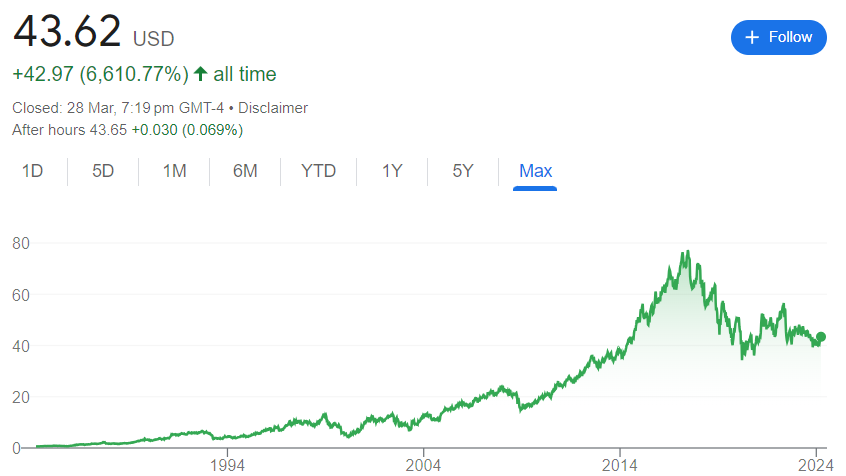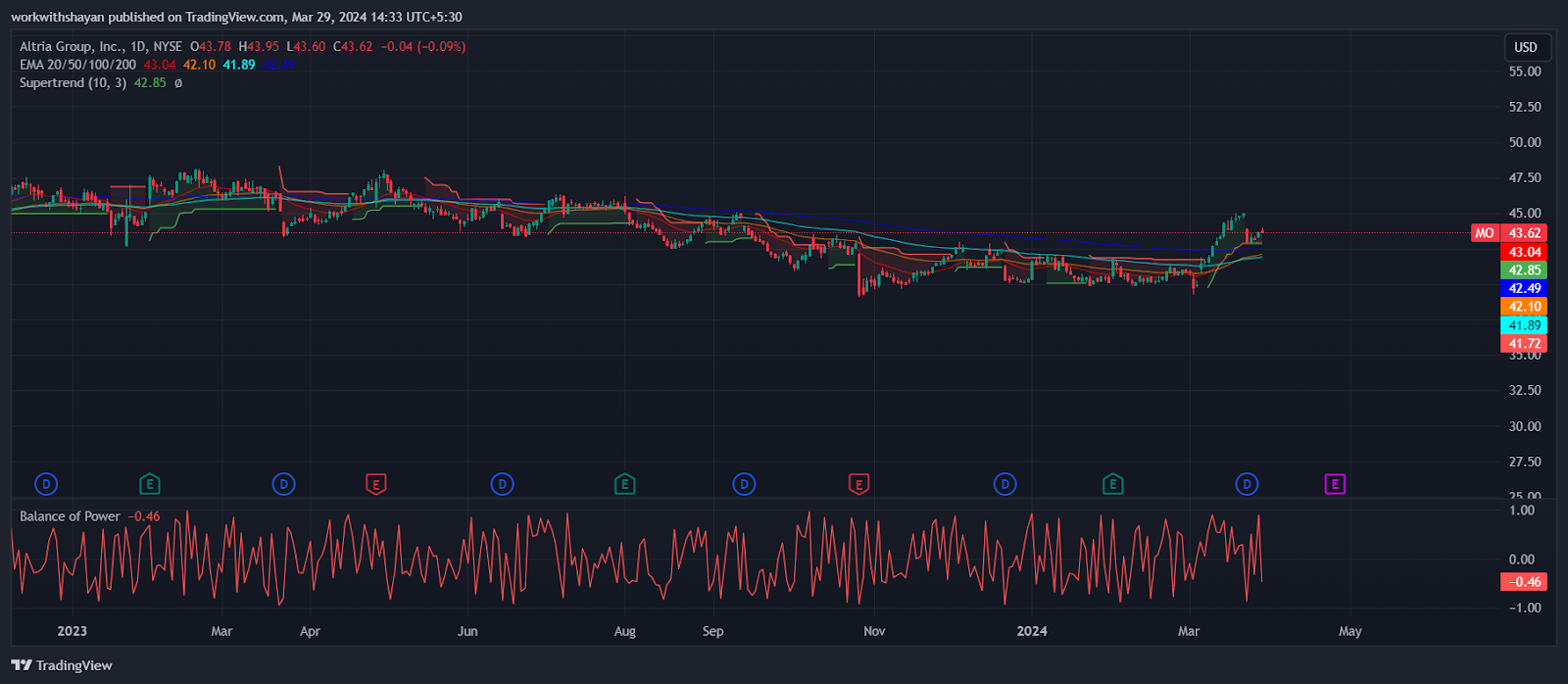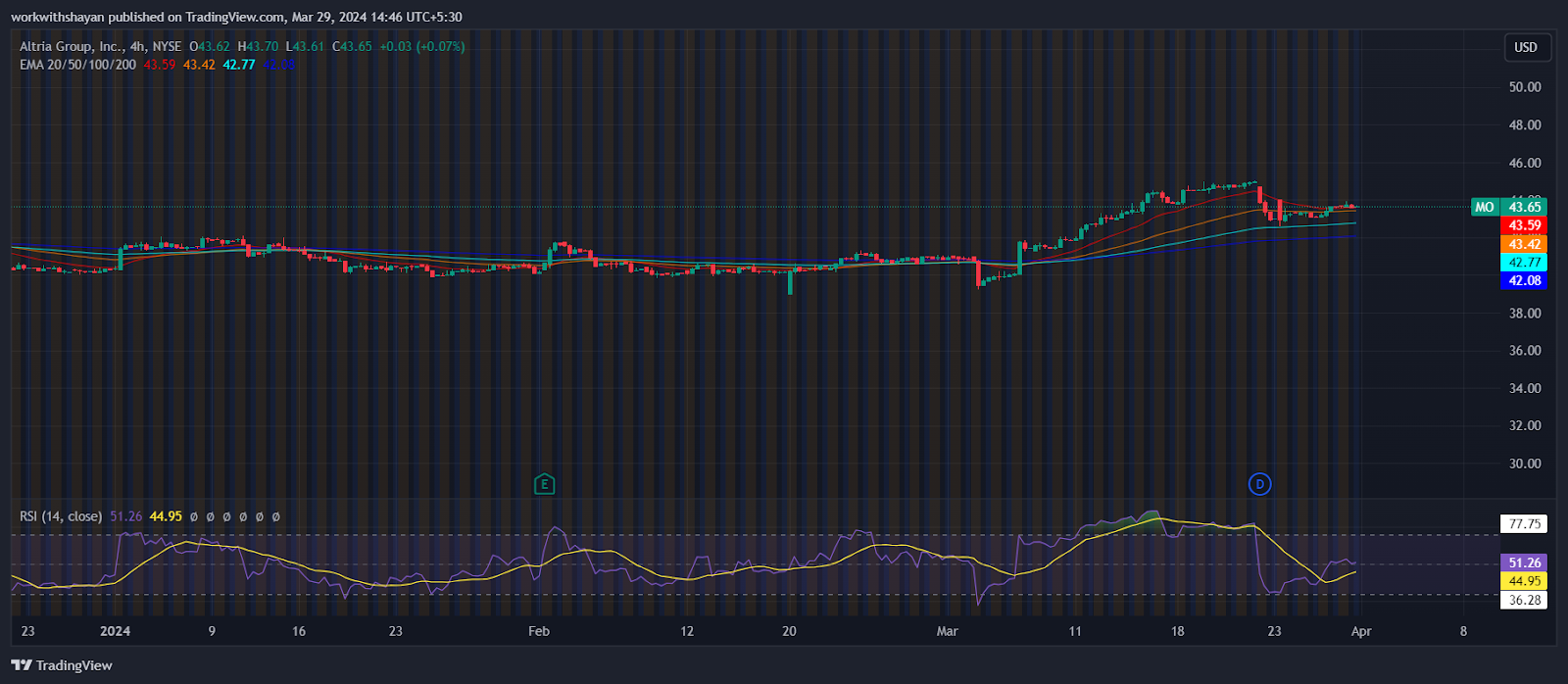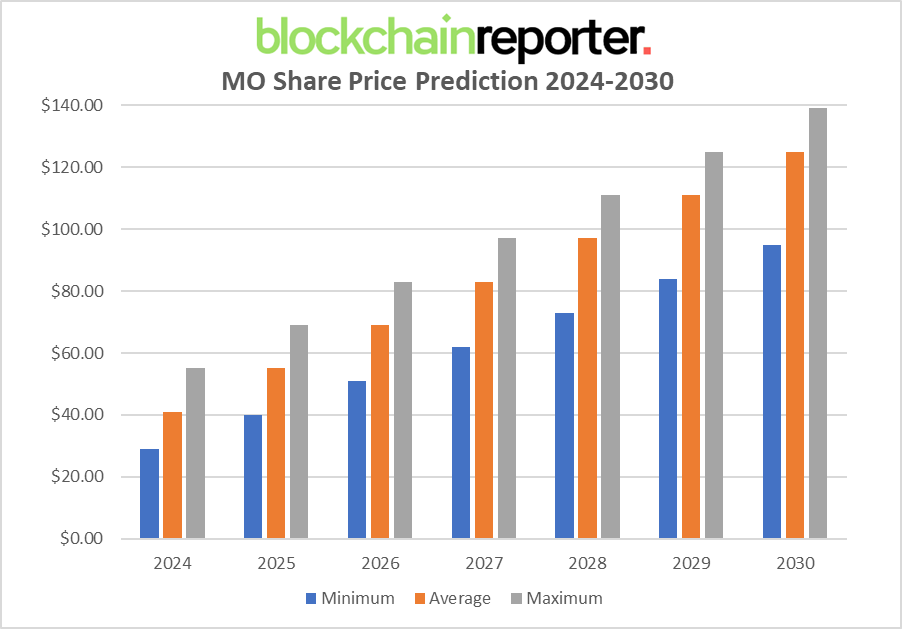
- Altria Group: A Quick Introduction
- Altria: History And Controversy
- Investments In 2007-2023
- Controversy And Political Connection
- MO Share Price Prediction: Price History
- MO Dividend History
- MO Share Price Prediction: Technical Analysis
- MO Share Price Prediction By Blockchain Reporter
- MO Share Price Prediction 2024
- MO Share Price Prediction 2025
- MO Share Price Prediction 2026
- MO Share Price Prediction 2027
- MO Share Price Prediction 2028
- MO Share Price Prediction 2029
- MO Share Price Prediction 2030
- MO Share Price Target: By Experts
- Financials
- Conclusion
Altria Group, Inc. might not be a household name for everyone, but for those in the know, it’s a pretty big company. This company has its fingers in a bunch of pies, but it’s mostly famous for its role in the tobacco industry. It’s been around for ages, really, kind of growing and changing alongside America itself. It’s seen all sorts of ups and downs, from shifts in what consumers want to navigating through heaps of new laws and health debates. But Altria’s story isn’t just about selling stuff. It’s also about how it’s adapted over time, switching things up as the market around it evolved. They’re based in Richmond, Virginia, and from there, they’ve managed to keep a steady hand on the wheel in their industry, getting involved in all sorts of discussions about where tobacco and nicotine are headed next. A big tobacco company like Altria probably has its fair share of fans and critics. Some people really admire how resilient and smart they’ve been in business, while others aren’t too thrilled about the whole ethical side of things. In recent years, the price of MO shares surged exponentially and it might soon record a massive gain following bullish MO dividend history. In this article, we’ll explore MO share price prediction with in-depth technical analysis and identify its market potential.
Altria Group: A Quick Introduction
Altria Group, Inc., originally known as Philip Morris Companies, Inc., stands as a major American entity and ranks among the globe’s leading producers and sellers of tobacco, cigarettes, and similar products. With operations spanning the globe, its headquarters nestle in Henrico County, Virginia, a stone’s throw from Richmond.
Serving as the umbrella organization, Altria oversees a family of companies including Philip Morris USA, John Middleton, Inc., U.S. Smokeless Tobacco Company, Inc., and Philip Morris Capital Corporation. Beyond its core tobacco business, Altria has ventured into the beverage and cannabis industries, holding significant minority interests in AB InBev, a renowned Belgium-based brewery, and Cronos Group, a Canadian cannabis firm.
Recognized for its economic influence, Altria is part of the S&P 500 index. It also featured in the Dow Jones Industrial Average from 1985 until 2008, exiting due to the spin-offs of Kraft Foods Inc. in 2007 and Philip Morris International in 2008.
Altria: History And Controversy
Altria was born out of a transformation from Philip Morris, marking a significant shift in the company’s identity in 2003. This rebranding was not just cosmetic; it underscored the company’s diversification beyond its original tobacco-centric portfolio, which at that time included a dominant 84% share in Kraft Foods, although this part of the business was later spun off. The choice of the name “Altria,” derived from a Latin term suggesting “highness,” followed a trend where companies adopted entirely new, previously non-existent names to signify a fresh start or new direction—Accenture and Verizon are prime examples of this trend. However, some critics, like linguist Steven Pinker, argue that Altria’s name change was an attempt to reframe the company’s image from one associated with negative health impacts to one suggestive of more noble values, a technique known as phonesthesia.
The strategic name change was proposed as a way to mitigate the negative connotations of the tobacco business and thereby enhance the company’s overall image, as suggested by its branding consultants, the Wirthlin Group. This move was seen as a tactic to shield the broader corporation and its subsidiaries from the mounting political and public scrutiny over tobacco products.
The rebranding of Philip Morris to Altria occurred against a backdrop of significant societal, legal, and financial challenges. By 2003, Altria had enjoyed a prominent position in the Fortune rankings at number 11, but experienced a notable decline in the following years, dropping to 137th by 2010, while Philip Morris International, once part of its portfolio, ranked higher at 94th.
In legal arenas, Philip Morris faced accusations and a landmark court ruling in 2006, where it was found to have deliberately contested scientific evidence linking smoking to health issues, despite knowing these assertions to be false. The court further implicated Altria, along with other major tobacco companies, in misleading the public about the dangers of smoking. Specifically, the court highlighted how these companies had altered the chemical composition of nicotine in cigarettes to enhance addiction, employing methods like “freebasing” through ammonia to increase the potency and addictive nature of their products.
Investments In 2007-2023
In 2007, Altria spun off its 88.1% stake in Kraft Foods to its shareholders and began distributing its Philip Morris International shares, completing the spin-off in 2008. That same year, it acquired cigar manufacturer John Middleton Co. The spin-off of Philip Morris International led to significant operational changes, including the closing of a North Carolina plant, a major cutback in manufacturing, and widespread layoffs, primarily affecting employees in Richmond, Virginia, and North Carolina. In 2008, Altria moved its headquarters from New York City to Richmond, Virginia.
The company faced layoffs and downsizing in 2007-2008 due to reduced demand from Philip Morris International subsidiaries. In 2009, Altria purchased UST Inc., expanding into smokeless tobacco and wine. Significant investments include acquiring a 45% stake in Cronos Group in 2018 for $1.8 billion, and a 35% stake in JUUL Labs for $12.8 billion, though the JUUL investment drastically reduced in value over time. Altria also entered into ventures with Swiss tobacco company Burger Söhne in 2019 and formed Horizon Innovations LLC with Japan Tobacco in 2022 to sell Ploom heated tobacco sticks in the U.S. Altria completed the acquisition of NJOY Holdings, Inc. in 2023.
Controversy And Political Connection
Between 1998 and 2004, Altria Group was one of the top spenders in lobbying the U.S. government, investing approximately $101 million, according to the Center for Public Integrity. This made it the organization with the second-highest lobbying expenditure in the country during that period.
Additionally, Altria supported The Advancement of Sound Science Coalition, an organization known for challenging the widely accepted scientific view on human-caused climate change.
Daniel Smith, an Altria representative, is a member of the American Legislative Exchange Council’s Private Enterprise Board. In a significant legal battle in August 2006, Altria was convicted of civil fraud and racketeering. The case against Altria argued that its promotion of “light” and “low tar” cigarettes misleadingly suggested these products were safer than regular cigarettes, a claim found to be fraudulent under the Maine Unfair Trade Practices Act (MUTPA) for deceiving consumers.
MO Share Price Prediction: Price History
Altria Group, Inc., known for its significant presence in the tobacco industry, commenced its journey with modest beginnings. On January 1, 1985, MO shares were trading at $3.36, adjusting for dividends and splits. The early years were marked by steady growth, as the company expanded its footprint in the tobacco industry, consistently increasing its dividend payouts, reflecting in the gradual uptick in its stock price.

The 1990s marked a period of significant expansion and growth for Altria. Notably, in October 1989, MO executed a 4:1 stock split, a move reflecting the company’s growth optimism. Throughout the 1990s, despite regulatory challenges faced by the tobacco industry, MO managed to sustain growth, closing the decade at $10 on January 1, 1999, post-dividend adjustments. This period underscored Altria’s strategic agility and its ability to navigate through legal and regulatory hurdles.
The turn of the century brought forth new challenges and opportunities for Altria. In October 2000, the stock witnessed significant volatility, reflecting the economic conditions and specific challenges within the tobacco sector. However, the company’s strategic decisions, including diversifications and spin-offs, allowed it to maintain a steady dividend policy, a key attraction for its investors. The price continued to surge in the following years and surged above $20 by the end of 2007.
The 2010s were characterized by Altria’s focus on stability and growth in its core tobacco business, while also exploring opportunities in adjacent sectors. The company’s stock price reflected this steady growth trajectory, supported by consistent dividend increases, a hallmark of Altria’s shareholder value proposition. The stock price continued to rise and touched the high of $75 in 2017.
Entering into the 2020s, Altria faced the dual challenges of navigating through the COVID-19 pandemic and adapting to the rapidly changing tobacco industry landscape, marked by a shift towards alternative tobacco and nicotine products. Despite these challenges, MO shares showed strong performance. For instance, on March 1, 2020, the stock was trading at $40.46 but faced volatility, dropping to $38.67 by the end of the month, amidst the pandemic-induced market turmoil.
As of the latest data in 2024, MO shares have shown signs of recovery and growth, trading at $43.6 on March 29, 2024.
MO Dividend History
The dividend history of MO, spanning from 1995 through 2024, illustrates not only the company’s commitment to returning value to its shareholders but also reflects its financial health and business strategy evolution over nearly three decades.
The dividend journey began in 1995 with a cash dividend of $0.825. Over the years, the company demonstrated a strong commitment to growing its dividend, a sign often associated with financial stability and confidence in future cash flows. By 2024, the dividend had grown to $0.98 per share, marking a substantial increase that showcases MO’s ability to generate and distribute wealth to its investors steadily.

A significant jump in the dividend payout was observed in 1997, with a cash dividend of $1.20, surging from the previous year’s $0.40. This leap signifies a pivotal moment, possibly reflecting a strategic shift or a substantial improvement in profitability. Following this peak, the dividend experienced fluctuations, notably returning to lower levels in 1998, starting at $0.40 and growing incrementally in subsequent years.
The early 2000s saw a gradual increase in dividend payments, reinforcing the company’s growth trajectory amidst the economic uncertainties of the dot-com bubble and the 2008 financial crisis. Despite these challenges, MO managed to maintain a steady pace of dividend growth, a testament to its resilience and strong business model.

MO’s dividend history is marked by consistent cash distributions, with dividends declared quarterly without interruption. This consistency underscores the company’s operational stability and its management’s confidence in sustaining cash flow to support these payments.
The increments in dividend payments, although varying in magnitude, highlight a cautious yet optimistic approach to capital management. Increases are typically seen as a signal of the company’s robust financial health and a bullish outlook on its future earnings potential.
In recent years, dividends have seen more modest increases, with the latest dividends from 2020 to 2024 hovering around $0.84 to $0.98. This pattern may reflect a mature company maintaining a balance between rewarding shareholders and investing in future growth opportunities.
Currently, the annual dividend is at $3.92 with a dividend yield of 8.98%. The latest dividend was recorded on 25 March and will be paid on 30 April.
MO Share Price Prediction: Technical Analysis
Recently, shares of MO have experienced a notable increase in value, contributing to its upward momentum. However, opposition from bearish traders at key resistance levels has led to a slight pullback in MO’s stock price to around $45. The stock’s performance has been positively influenced by the company’s financial outcomes and its dividend payouts, enhancing the appeal of its shares. A detailed analysis of MO’s technical charts indicates promising bullish patterns, though these could diminish if bearish pressure escalates. Given the ambiguous outlook for short-term growth, investors should proceed with caution. The sustainability of this uptrend is questionable, casting uncertainty on MO stock’s ability to retain its status as a premier investment choice.

MO/USD Chart On TradingView
According to TradingView, the current price of MO shares is $43.6, marking a modest decrease of over 0.09% in the last 24 hours. A detailed analysis of the MO stock price reveals a potential reversal from its recent downward movement, given its upward trajectory over the past few weeks. Despite encountering resistance at key levels, there seems to be a burgeoning interest for buying near immediate Fibonacci retracement levels, which might lead to a positive shift in momentum. Observations from the daily price chart indicate that MO shares have established a support level at approximately $42, a crucial juncture from which the price could attempt to breach upcoming resistance levels. With the stock price recently surpassing several Exponential Moving Average (EMA) trend lines after rising above $40, investors might be tempted to adopt long positions, which could propel the share price higher in the near term. The Balance of Power (BoP) indicator is currently positioned in a bearish zone at 0.46, hinting at a possible downward adjustment ahead.

MO/USD Chart On TradingView
To thoroughly analyze the price of MO shares, it is crucial to take a look at the RSI-14 indicator. The RSI indicator recently experienced a surge and it currently hovers at 51-level, around the midline, suggesting equilibrium. It is anticipated that MO stock price will soon attempt to break above its 38.6% Fibonacci level to achieve its short-term bullish goals. If it fails to climb above this Fibonacci region, a downtrend might occur.
As the SMA-14 continues its swing near the 44-level, it trades way below the RSI line, potentially accelerating the stock’s downward correction on the price chart. However, if MO shares break above the consolidation zone and surge above the EMA20 trend line, it can pave the way to the crucial resistance of $50. A breakout above the strong resistance will drive the share price toward the upper limit of the Bollinger band at $54.
Conversely, if MO stock price fails to hold above the critical support level of $40, a sudden collapse may occur, resulting in further price declines and causing the MO share to trade near the crucial support zone at $33.
MO Share Price Prediction By Blockchain Reporter

MO Share Price Prediction 2024
The MO stock is forecasted to achieve a minimum price of $29 in 2024. It is anticipated that the stock could reach a maximum price of $55, with an average trading price of $41 throughout the year.
MO Share Price Prediction 2025
Based on projections and market analysis, the price of MO stock in 2025 is expected to have a minimum value of $40. The maximum stock price is predicted to be $69, with an average value of $55 over the year.
MO Share Price Prediction 2026
The MO stock price in 2026 is projected to have a minimum of $51. The stock could see a maximum price of $83, with the year’s average price expected to be around $69.
MO Share Price Prediction 2027
For 2027, MO’s stock is forecasted to reach a minimum price of $62. The maximum price could climb to $97, with an average trading price of $83 throughout the year.
MO Share Price Prediction 2028
Predictions for 2028 indicate a minimum price of $73 for MO stock. The maximum price might reach $111, with an average price of $97 expected over the year.
MO Share Price Prediction 2029
The price of MO stock in 2029 is anticipated to have a minimum value of $84. The maximum price is forecasted to be $125, with an average price of $111 throughout the year.
MO Share Price Prediction 2030
In 2030, the MO stock is projected to see a minimum price of $95. The maximum stock price could reach $139, with the year’s average price likely to be around $125.
MO Share Price Target: By Experts
According to the latest insights from eight Wall Street analysts covering Altria Group over the past three months, the consensus 12-month price target for the company stands at $43.39. Predictions range from a high of $50.00 to a low of $36.09. This average target suggests a slight decrease of 0.53% from the recent trading price of $43.62.
Multiple research institutions have recently shared their opinions on Altria Group (MO). On Tuesday, January 23rd, UBS Group reiterated a sell rating for Altria Group, setting a price goal of $36.10 in their report. Stifel Nicolaus, on the other hand, confirmed a buy rating with a price target of $50.00 in their analysis released on Monday.
Among analysts, the stock received one sell rating, one hold rating, and three buy ratings. MarketBeat data shows that Altria Group currently holds an average rating of Hold, with a consensus target price of $46.82.
Financials
Altria Group, Inc. has shared its financial results for the fourth quarter and the entire year of 2023, along with its outlook for 2024. The company achieved a 2.3% growth in adjusted diluted earnings per share (EPS) and returned nearly $7.8 billion to shareholders through dividends and share repurchases. CEO Billy Gifford highlighted the year’s success in navigating a challenging market while expanding Altria’s smoke-free product line, indicating a strategic move towards a future beyond traditional tobacco products.
Looking ahead, Altria anticipates adjusted diluted EPS for 2024 to be between $5.00 and $5.15, suggesting a growth rate of 1% to 4% from 2023’s base of $4.95. This forecast reflects the company’s balanced approach to growth, shareholder returns, and investment in its vision for a smoke-free portfolio.
Conclusion
Altria Group is getting mixed reviews from the experts, pointing to a situation where some caution and optimism are both present. The variety in recommendations—ranging from selling to buying—shows that people have different thoughts on how the company will perform.
Overall, the advice leans more towards a “wait and see” approach, suggesting that while there may be some positive movement ahead, it’s worth taking a careful look from all angles, not just focusing on the stock price, but also considering the company’s overall health and future prospects before making any investment decisions.









